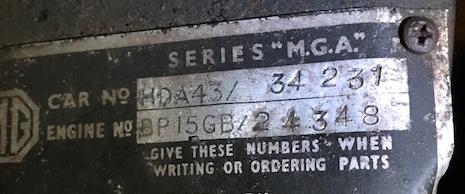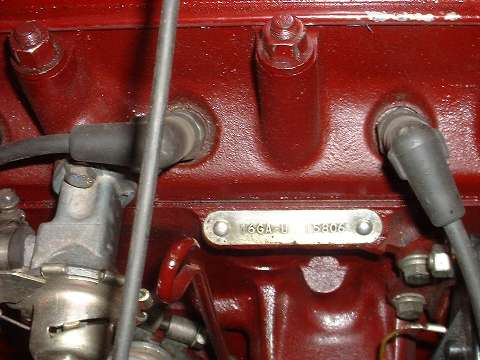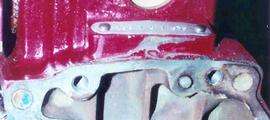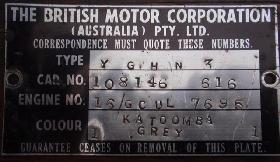The MGA With An Attitude
MGA NUMBERS TECH -- BUY-101D
Engine Number
For the MGA 1500 cars, at least through 1958, the original engine number was stamped on the large ID plate along with the Car Number, and the Car Number included a few other things, like the paint color code for the body.

Car No. plate with early style numbers
For later cars the box on the ID plate for the engine number was simply printed with "See Engine", and most of the extra characters in the Car Number may have been left out leaving only a 5-digit serial number for the Car Number (or maybe 6 digits with a leading "1" for the latest production from early 1961 through June 1962).

Engine number plate at top edge of engine block
 The engine number, if it still remains, would be found in raised stamped numerals on a small aluminum tag attached to the top corner of the engine block with two drive rivets just below the head gasket between #2 and #3 spark plugs. It is not uncommon for the tag to be missing (and no great crime either). During the machining process for re-boring the cylinders for an engine rebuild the engine block is normally "hot tanked" for cleaning, and this process will dissolve the aluminum tag if it was left on the block. If there is a tag there it is not unusual for it to be somewhat mutilated from the process of removal and re installation, or it might be a spanking new issue created to replace a missing or damaged tag. It is also very common for the engine to be a replacement unit, in which case it should have a different number than the original engine. In the end, only a real concours enthusiast would even care if the engine number was as original. It might be of some concern that the engine should be the original type, as having a 1500 engine in a 1500 car, but even that is of little concern for a daily driver. My 1500 car currently carries a 1600 engine with a cylinder head from an 1800 engine, and I have a 1622 engine under the workbench for a spare. It is usually considered fair game to mix and match these engine parts, except that people don't usually like an engine that is smaller displacement than original, and a fair number might actually object to an MGB 1800 engine in the MGA, even though more would welcome it with open arms.
The engine number, if it still remains, would be found in raised stamped numerals on a small aluminum tag attached to the top corner of the engine block with two drive rivets just below the head gasket between #2 and #3 spark plugs. It is not uncommon for the tag to be missing (and no great crime either). During the machining process for re-boring the cylinders for an engine rebuild the engine block is normally "hot tanked" for cleaning, and this process will dissolve the aluminum tag if it was left on the block. If there is a tag there it is not unusual for it to be somewhat mutilated from the process of removal and re installation, or it might be a spanking new issue created to replace a missing or damaged tag. It is also very common for the engine to be a replacement unit, in which case it should have a different number than the original engine. In the end, only a real concours enthusiast would even care if the engine number was as original. It might be of some concern that the engine should be the original type, as having a 1500 engine in a 1500 car, but even that is of little concern for a daily driver. My 1500 car currently carries a 1600 engine with a cylinder head from an 1800 engine, and I have a 1622 engine under the workbench for a spare. It is usually considered fair game to mix and match these engine parts, except that people don't usually like an engine that is smaller displacement than original, and a fair number might actually object to an MGB 1800 engine in the MGA, even though more would welcome it with open arms.

For the MGA Twin Cam engines, the engine number plate was attached to a horizontal surface on the rear of the engine behind the cylinder block.
In case you find an engine number that does not follow the expected format for an MGA, you can consult a list of B.M.C. & Morris Engine Codes to determine if it may have come from some other model car.
To remove the engine number plate you can grind a slot in the rivet head with an abrasive wheel and unscrew it with a BIG flat blade screwdriver. It helps if you can get a knife blade underneath to assist in lifting while you turn it anti-clockwise. Once it comes up a little you can get it with ViceGrip if needed. I have always been able to unscrew them that way.
On October 21, 2012, Andrew Williams in Launceston, Tasmania, Australia wrote:
"Here's one I prepared earlier. I was surprised how easily the rivets came undone".


On 7/15/2020, Simon Broom wrote:
"My buddy Billy Allen of Billy Allen Autos found another method which took about 2 minutes BUT it does mean breaking the old plate. Simply lever the middle of the plate up until it tears in two (easy on an old plate), fold the outer and inner edges upwards on both sides to form 'ears' either side of the rivets. Put pliers over and turn Ė because you have a very firm grip and leverage even these rusted rivets shifted".
On 7/15/2020, Simon Broom wrote:
"Todd at Clarke Spares asserts that the MGA has either an 'H' or an 'L' recessed or embossed on the engine number to denote a high or low compression engine. I have discovered that for UK cars like mine at any rate this does not appear to be the case. My engine number is: '16GA U 14920' and thatís it. My Car is right hand drive, MK 1 1600 roadster, manufactured in January 1960 and sold in March and it has been owned outside the UK. Todd suggested that the L or H may be recessed or lightly stamped and will have disappeared under the dirt and age. I looked once it was off and cleaned up and it simply isnít there. Maybe itís not the original plate, but why would someone miss off information on a re-stamped one especially if they went to the trouble of removing it in the first place? So I did some research, itís a 1600 block, it has 1600 cast on the side, I have records of work going back 60 years including head work but nothing on engine replacement and the engine number correlates with the VIN number, the log book and original date of manufacture all within a range that 90% suggests itís the original block to the car. I had this confirmed (as far as is possible to do so) with the MG Car Club. I have also looked at the engine numbers of several other UK MGAs and none of them have the L or H. The plate was very old so it probably is the original one. Finally, MiniMail an old and established UK manufacturer of engine number plates for old BMC cars says he has never seen 'L' or 'H' on an old MGA engine plate he was reproducing".
Now I have a theory about this issue. Engines are not all the same, but they do all have a unique serial number. The engine number tags are reverse stamped, leaving an open space in the center for the 'H' or 'L' to be hand stamped later. The tags would be installed very early in engine production, possibly the first part to be installed on the bare engine block. Individual engines, or possibly groups of engines, may have a recipe card with a list of parts and any special instructions. This is the point where an engine might be special ordered, like with a non-standard cam shaft or pistons or paint color for instance. When the pistons were installed the number tag would be stamped with 'H' or 'L' to match the piston type used, which is why that letter in the middle is front stamped. Since a majority of the engines were high compression, at some point it may have been decided that the 'H' stamp was not needed, as it would be high compression by default, unless otherwise specified. In that case, only the 'L' stamp would be applied as needed. This seems to be the case for later production cars where many (possibly all) of the high compression engines were not stamped.
Australian built CKD cars had a different Vehicle ID Plate to conform to local law. Here the third line contained the engine number. The engine number was also stamped on the engine, as the factory type riveted plate was not allowed.


|


 The engine number, if it still remains, would be found in raised stamped numerals on a small aluminum tag attached to the top corner of the engine block with two drive rivets just below the head gasket between #2 and #3 spark plugs. It is not uncommon for the tag to be missing (and no great crime either). During the machining process for re-boring the cylinders for an engine rebuild the engine block is normally "hot tanked" for cleaning, and this process will dissolve the aluminum tag if it was left on the block. If there is a tag there it is not unusual for it to be somewhat mutilated from the process of removal and re installation, or it might be a spanking new issue created to replace a missing or damaged tag. It is also very common for the engine to be a replacement unit, in which case it should have a different number than the original engine. In the end, only a real concours enthusiast would even care if the engine number was as original. It might be of some concern that the engine should be the original type, as having a 1500 engine in a 1500 car, but even that is of little concern for a daily driver. My 1500 car currently carries a 1600 engine with a cylinder head from an 1800 engine, and I have a 1622 engine under the workbench for a spare. It is usually considered fair game to mix and match these engine parts, except that people don't usually like an engine that is smaller displacement than original, and a fair number might actually object to an MGB 1800 engine in the MGA, even though more would welcome it with open arms.
The engine number, if it still remains, would be found in raised stamped numerals on a small aluminum tag attached to the top corner of the engine block with two drive rivets just below the head gasket between #2 and #3 spark plugs. It is not uncommon for the tag to be missing (and no great crime either). During the machining process for re-boring the cylinders for an engine rebuild the engine block is normally "hot tanked" for cleaning, and this process will dissolve the aluminum tag if it was left on the block. If there is a tag there it is not unusual for it to be somewhat mutilated from the process of removal and re installation, or it might be a spanking new issue created to replace a missing or damaged tag. It is also very common for the engine to be a replacement unit, in which case it should have a different number than the original engine. In the end, only a real concours enthusiast would even care if the engine number was as original. It might be of some concern that the engine should be the original type, as having a 1500 engine in a 1500 car, but even that is of little concern for a daily driver. My 1500 car currently carries a 1600 engine with a cylinder head from an 1800 engine, and I have a 1622 engine under the workbench for a spare. It is usually considered fair game to mix and match these engine parts, except that people don't usually like an engine that is smaller displacement than original, and a fair number might actually object to an MGB 1800 engine in the MGA, even though more would welcome it with open arms. 



